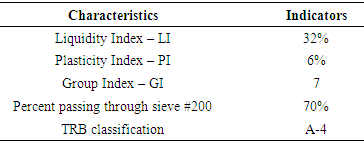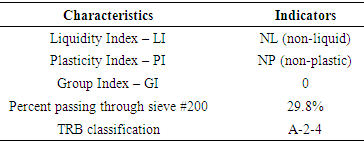-
Paper Information
- Next Paper
- Paper Submission
-
Journal Information
- About This Journal
- Editorial Board
- Current Issue
- Archive
- Author Guidelines
- Contact Us
International Journal of Materials Engineering
p-ISSN: 2166-5389 e-ISSN: 2166-5400
2018; 8(5): 90-96
doi:10.5923/j.ijme.20180805.02

Technical Feasibility of Using Construction Waste (Sand Fraction) as Stabilizing Agent in Sinop City (Brazil) Soil
Wdson Gurierizz de Oliveira Alves1, Gustavo Henrique Nunes1, João Paulo Boff Almeida1, Francieli Schoenhals Delavy1, André Luis Christoforo2, Francisco Antonio Rocco Lahr3, Julio César Beltrame Benatti1
1Department of Civil Engineering, University of Mato Grosso State (UNEMAT), Sinop, Brazil
2Department of Civil Engineering (DECiv), Federal University of São Carlos (UFSCar), São Carlos, Brazil
3Department of Structural Engineering (SET), São Carlos Engineering School, São Paulo University (EESC/USP), São Carlos, Brazil
Correspondence to: André Luis Christoforo, Department of Civil Engineering (DECiv), Federal University of São Carlos (UFSCar), São Carlos, Brazil.
| Email: |  |
Copyright © 2018 The Author(s). Published by Scientific & Academic Publishing.
This work is licensed under the Creative Commons Attribution International License (CC BY).
http://creativecommons.org/licenses/by/4.0/

The development of the civil construction industry generates major problems, such as the production of construction waste. This complication is aggravated mainly in municipalities where there is no management and disposal policy, as it is the case of Sinop, Mato Grosso (MT), Brazil. A possible solution to this environmental problem in that municipality is the application of ground waste to sand fraction as stabilizer in order to increase resistance of the regional subgrade. The latter is characterized as having a low-bearing soil capacity. Furthermore, this strategy may allow for soothing of other problems, such as granular material extraction from the environment. This paper sought answers to improve the low-bearing soil capacity in Sinop, which was granulometrically and mechanically stabilized by having natural soil mixed with two percentages of construction waste: 25% and 50%, with two compaction energies: normal and intermediate. Samples were subjected to tests for characterization and resistence. Results show relevant improvement in handling material characteristics. Natural soil, characterized as A-4 TRB, from bad to poor subgrade performance, and 12.2% CBR, with blend in three CBR cases as well as expansion, conformed to be sub-base material (CBR > 20%). Additionally, in one of the cases, it conformed to be base material (CBR > 60%). However, even though material with good resistance and bearing capacity was obtained, it was not possible to reach conclusions on its technical feasibility due to grain size not fitting ABNT NBR 15115 specification.
Keywords: Construction Waste, Soil Improvement Techniques, California Bearing Ratio (CBR)
Cite this paper: Wdson Gurierizz de Oliveira Alves, Gustavo Henrique Nunes, João Paulo Boff Almeida, Francieli Schoenhals Delavy, André Luis Christoforo, Francisco Antonio Rocco Lahr, Julio César Beltrame Benatti, Technical Feasibility of Using Construction Waste (Sand Fraction) as Stabilizing Agent in Sinop City (Brazil) Soil, International Journal of Materials Engineering , Vol. 8 No. 5, 2018, pp. 90-96. doi: 10.5923/j.ijme.20180805.02.
Article Outline
1. Introduction
- Demographic growth of cities requires greater investment in urban infrastructure. One of the main investments is paving, which brings better quality of life and benefits to the population. The costs of urban paving are high due to the need for large-scale extraction of granular material to be applied to paving layers, for example. These layers are thicker and more expensive as the bearing capacity of the subgrade soil is worse.In addition to high costs, extraction of granular material to construct base layers, sub-base, and for subgrade reinforcement in paving creates environmental problems. This is aggravated when material is available in deposits located in regions near environmentally protected areas [1, 2].Sinop-MT is located in a region with low-bearing capacity of soils as subgrade soil [3]. Therefore, there is a need for soil improvement or replacement in order to allow for paving. Additionally, a large part of deposits located in the municipality are near Teles Pires River where environmental impacts associated with extraction are considerable. An economic alternative to improve mechanical behavior of local soils is the implementation of stabilization techniques [4]. One modification technique of geotechnical properties is mechanical stabilization through compaction and mixing of soils with different characteristics [5].According to Pereira et al. [6], compactation is the mechanical action imposed to the soil through the application of compressive strength. This results in reduction of void ratio with air-expulsion. This process aims to improve soil properties for engineering purposes, based on an increase in resistance and particle cohesion [7, 8].It is extremely important to know the maximum bearing capacity of soil, keeping its functions preserved [9]. When the soil does not have satisfactory resistance, it is possible to improve its behavior by adding other soils and materials [6]. An alternative to improve the bearing capacity of local soil is the use of construction waste (RCC) as stabilizing granular material. This solution, in addition to minimizing the necessity of natural material deposits, contributes to another demand of this municipality: the production of construction waste associated with the unavailability of adequate places for its disposal [10, 11]. Thus, this study aims to offer an alternative for the improvement of the municipality’s soil, while verifying the technical feasibility of using recycled aggregates, and using construction waste in sand fraction as a stabilizer of natural material. The modified soil can offer technical conditions and allow for its application in base layers, sub-base and subgrade reinforcement of urban paving.
2. Theoretical Basis
2.1. Soils of Sinop-MT (Brazil)
- According to Pedology, the predominant soil in Sinop-MT is classified as red-yellow latosol, with quartz sands and plinthosols, as well as a laterite layer near Teles Pires River [12]. This laterite layer, also known as "gravel", is a type of material widely used for paving due to having good performance and good bearing capacity. The Transportation Research Board (TRB) classification characteristic of Sinop region (Table 1) suggests silt-clay material that has poor behavior as subgrade material [13].
|
|
2.2. Civil Construction Waste
- Civil construction waste can be mixed with soils for paving with the objective of improving geotechnical properties, reducing costs and minimizing environmental damage [11, 17].The CONAMA 307 [18] resolution was introduced based on the need to implement guidelines to reduce environmental damage produced by construction materials, since their disposal in inappropriate places contributes to degradation of environmental quality. Managing those materials should provide social, economic and environmental benefits, considering technical and economic feasibility of production and use. Its 3rd Art. defines the classes they should fit: A, B, C and D. Class A is the only one that can be used in paving layers, and may consist of materials from construction, demolition, renovation, paving repairs, as well as soil from land grading work. Some of the materials that fall under this classification are bricks, blocks, tiles, veneers, mortar, concrete, and tubes [18].
2.3. Soil Stabilization for Paving
- Stabilization aims at improving soil properties, such as strength, permeability, deformability. Stabilized soil is defined as cases in which resistance gains are acquired with the use of additives, whereas improved soil is defined when improvement of other properties is sought, without significant gain of resistance [13]. The process has the function of transforming a given soil through artificial techniques, allowing it to serve different types of engineering work, in addition to its adaptation to different projects. The main methods employed for soil stabilization are shown in Figure 1.
 | Figure 1. Methods of soil stabilization [13] |
2.4. Stabilization with RCC
- There are many examples of RCC application in Brazil as well as worldwide. Many countries have their own specifications for quality control in production and application of this material. Research on the application of recycled aggregates to paving has been conducted for many years and in many places [19].The creation of Alternative Materials in Road Construction (ALT-MAT) was achieved by joining some European countries with the purpose of finding alternative materials for paving. The organization states that materials should be characterized according to each region, as local factors exert significant influence. Studies conducted by the organization obtained more satisfactory field-performance results than expected [20]. Hortegal et al. [21] state that RCC has demonstrated good behavior in pavement layers, thus becoming a very interesting and viable alternative, since it has great availability provided by existing recycling technologies. In addition, it is a renewable alternative capable of replacing natural materials, especially in low-volume traffic routes.RCC in pavement layers has been used since the 1970s in the Netherlands, being a common practice [22]. In Brazil, the first register of a road paved with RCC was in the city of São Paulo in 1984, with RCC application in subgrade reinforcement layer. Execution was followed up by the Technological Research Institute of the State of São Paulo (Instituto de Pesquisas Tecnológicas do Estado de São Paulo), presenting satisfactory performance. In the same decade, a program was created and implemented in order to recycle materials from civil construction to paving. Studies and research led to the conclusion that it was material with good behavior for application to urban pavements [23, 24].
3. Material and Methods
3.1. Soil
- The soil used in this research was collected from the subsoil of Estrada Nanci (Nanci Road) in Sinop-MT. Collection was made at the location shown in Figure 2, with the following geographic coordinates: 11°50'36.2"S; 55°33'32.6"W.
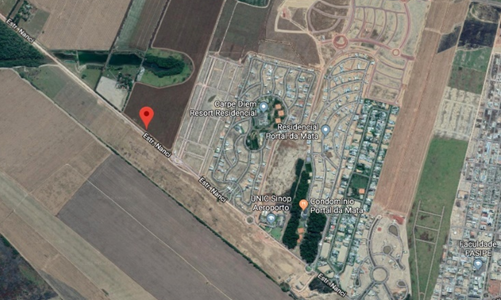 | Figure 2. Soil collection site (source: Google Maps, 2018) |
 | Figure 3. (a) Collecting soil; (b) Drying of soil |
3.2. Construction Waste
- The construction waste used (Figure 4) was collected from construction works of a private company in Sinop-MT. The material was milled by the company’s own grinder.
 | Figure 4. Drying of RCC |
3.3. Geotechnical Characterization
- Characterization of pure soil, pure construction waste and blends (25% construction waste and 75% soil; 50% construction waste and 50% soil) was carried out by means of Atterberg limits tests [25, 26], granulometry [27], and TRB classification [13].
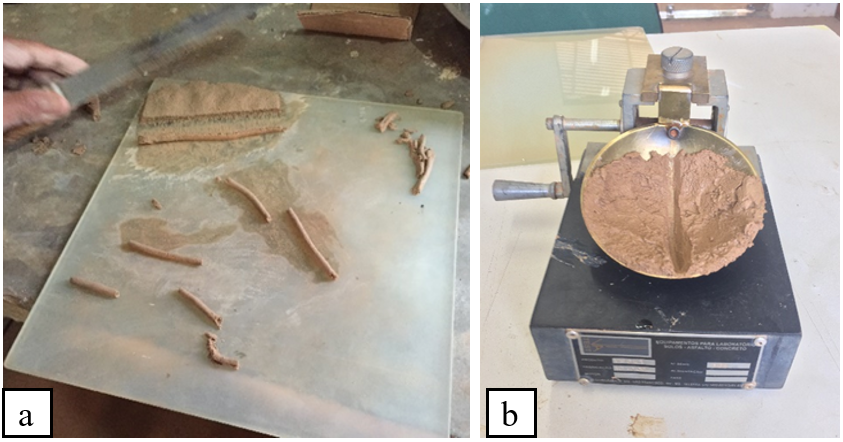 | Figure 5. (a) Plasticity Index; (b) Liquidity Index |
3.4. Mechanical and Granulometric Stabilization with Construction Waste
- The behavior of materials was analyzed, according to ABNT NBR 7182 [28], with two different energies: normal and intermediate; as well as two blending percentages: 25% construction waste and 75% soil; 50% construction waste and 50% soil. Pure soil and pure construction waste analyses were also performed.In order to standardize the procedures, compaction tests were performed with the small cylinder (10 cm in diameter and 12 cm in height), as shown in Figure 6 and specified by ABNT NBR 7182 [28]. Samples were homogenized (Figure 7) and subjected to compaction test. Pure soil curve with intermediate energy was adapted from the study conducted by Dalla Roza and Crispim [3].
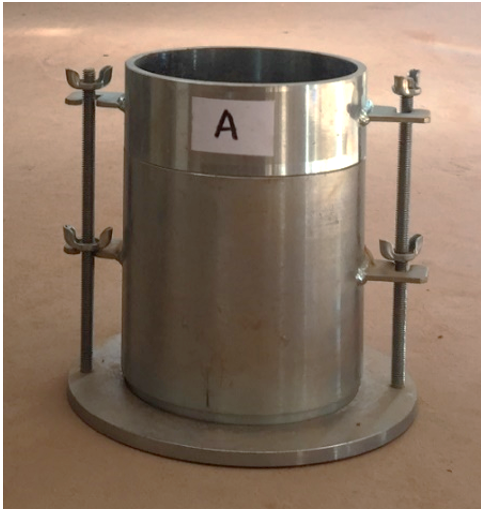 | Figure 6. Small specimen |
 | Figure 7. Homogenization of mixtures |
3.5. CBR e Expansion
- Two specimens were molded and ruptured for each material, one with normal energy and one with intermediate energy, optimum moisture point and maximum specific dry weight. The points were found through compaction curves in accordance with ABNT NBR 9895 [29]. Figure 8 shows the CBR test.
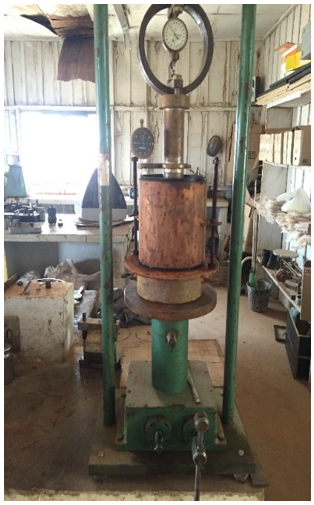 | Figure 8. CBR test |
4. Results and Discussion
4.1. Geotechnical Characterization
- Results from Atterberg Limits test and TRB classification are presented in Table 3.
|
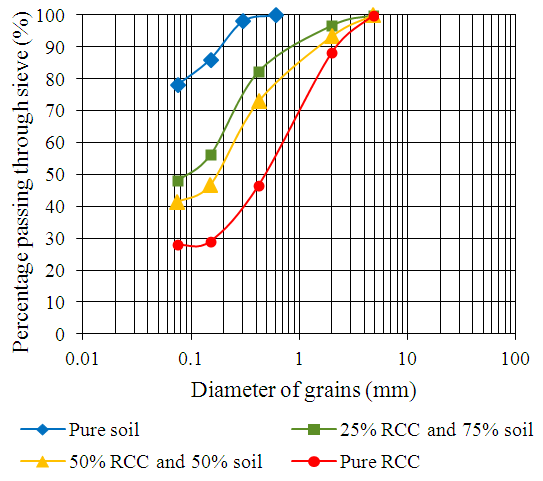 | Figure 9. Granulometric curves of materials |
4.2. Mechanical and Granulometric Stabilization with Construction Waste
- Curves obtained from the compaction test with normal and intermediate energy are presented in Figures 10 and 11, respectively, and the corresponding results of
 and
and  are shown in Tables 4 and 5.
are shown in Tables 4 and 5. | Figure 10. Compaction curves – normal energy |
|
 | Figure 11. Compaction curves – intermediate energy |
|
 was found in soil with addition of 25% of construction waste. It was also noted that pure construction waste presents a fairly higher value of optimum moisture. This fact may be associated to the porous structure of the material, which absorbs a significant amount of water. Intermediate energy behavior is similar, with the ideal condition (maximum specific apparent dry weight) being the one noted in the blend having 50% of construction waste.Altogether it is possible to affirm that both blends show a better behavior when compared to pure materials, thus suggesting that granulometric stabilization of soil with construction waste is technically efficient.
was found in soil with addition of 25% of construction waste. It was also noted that pure construction waste presents a fairly higher value of optimum moisture. This fact may be associated to the porous structure of the material, which absorbs a significant amount of water. Intermediate energy behavior is similar, with the ideal condition (maximum specific apparent dry weight) being the one noted in the blend having 50% of construction waste.Altogether it is possible to affirm that both blends show a better behavior when compared to pure materials, thus suggesting that granulometric stabilization of soil with construction waste is technically efficient.4.3. CBR and Expansion
- Based on CBR tests results, it was possible to create a chart in which the result of CBR is associated with the percentage of construction waste addition, as shown in Figure 12. There was no expansion in neither tested samples. The summary of values is shown in Table 6.
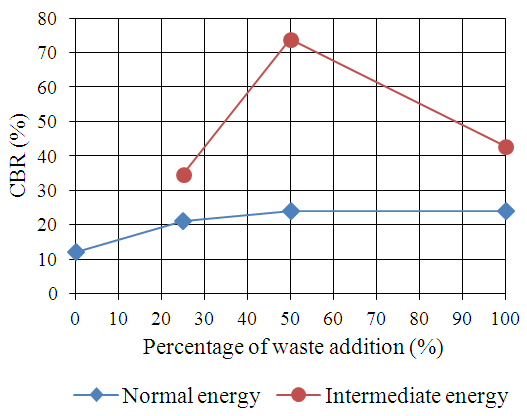 | Figure 12. CBR versus addition of construction waste |
|
5. Conclusions
- This paper analyzed the technical feasibility of using construction waste (RCC) in sand fraction as stabilizing agent in Sinop-MT (Brazil) soil. The natural soil of the city, known for its low-bearing capacity, is classified by TRB as A-4.The application of soil blends and construction waste tested under two normative energies results in significant improvement in bearing capacity. However, compounds granulometry does not meet ABNT NBR 15115 [30] which lays down that the percentage of material passing through #40 sieve must be under 40%.Data on CBR and expansion tests show the addition of 50% construction waste to intermediate energy enables the blend to be used for grade layers with CBR of 74%. The blend containing 25% of construction waste with intermediate energy and even blends of 25% or 50% of construction waste with normal energy result in a CBR above 20%, thus qualifying its application to subgrades layers.The significant improvements in soil bearing capacity show the potential of applying civil construction waste in urban pavement layers. Nevertheless, there is a need for correcting blends granulometry in order to meet Brazilian guidelines.Finally, the paper concludes that as construction waste (RCC) is added to the natural soil in question, CBR increases to some degree and then decreases. Even with 100% of construction waste (pure RCC), CBR is better than that of pure natural soil. This fact highlights how bad the bearing capacity of soil in Sinop-MT (Brazil) is.
 Abstract
Abstract Reference
Reference Full-Text PDF
Full-Text PDF Full-text HTML
Full-text HTML